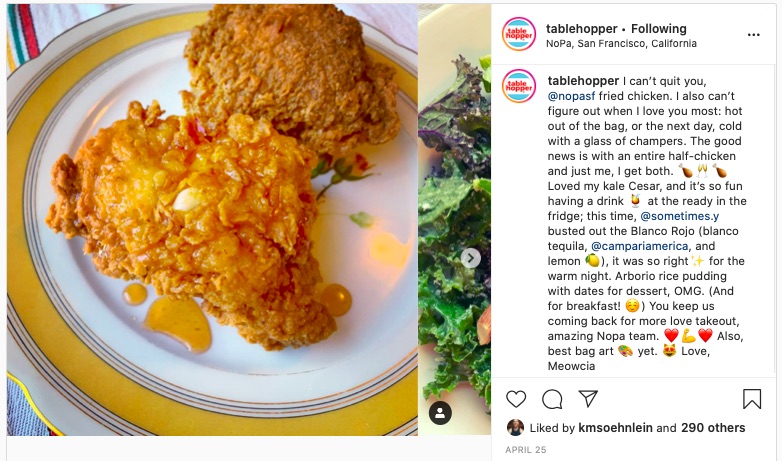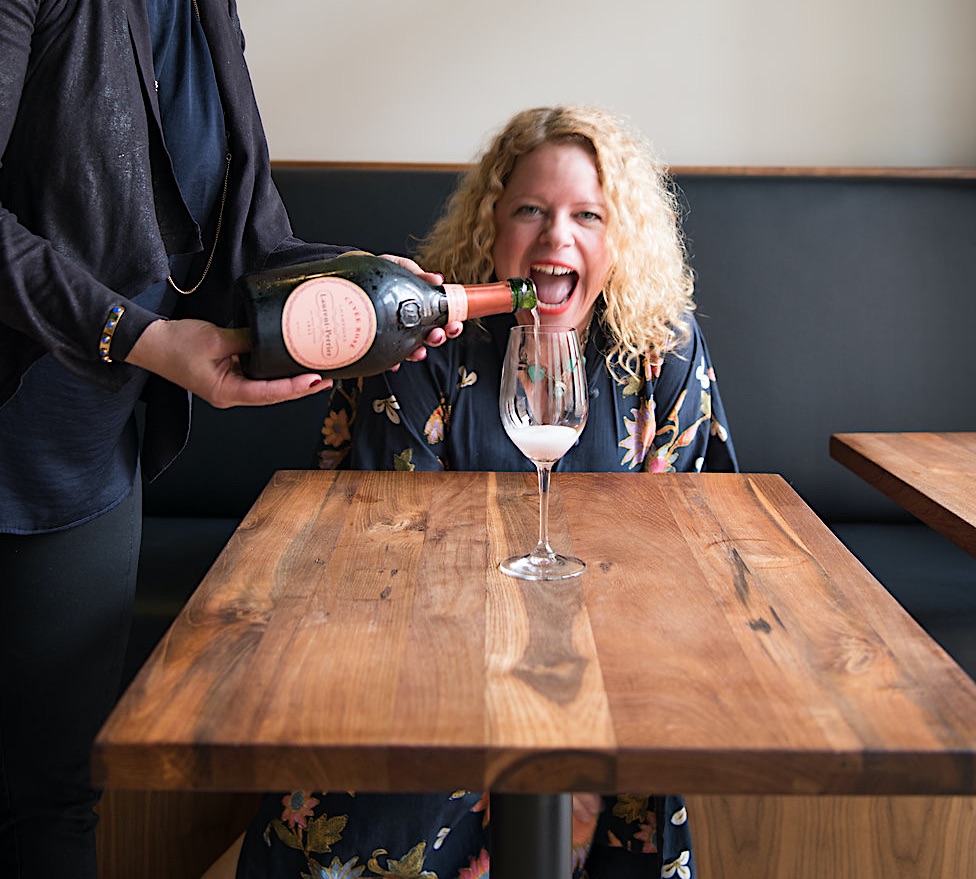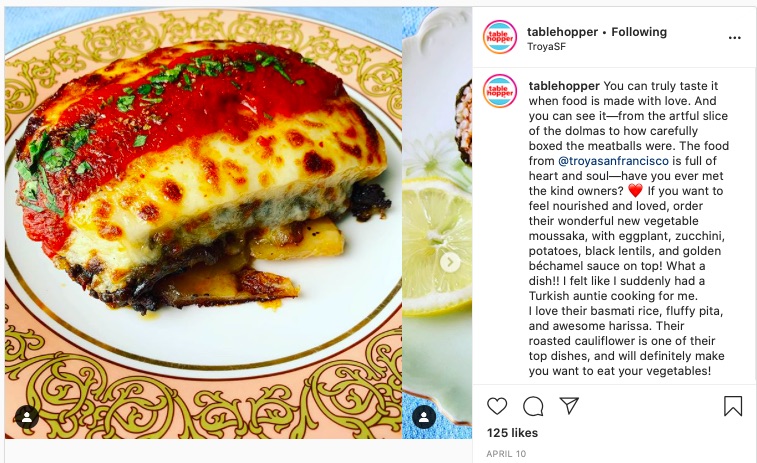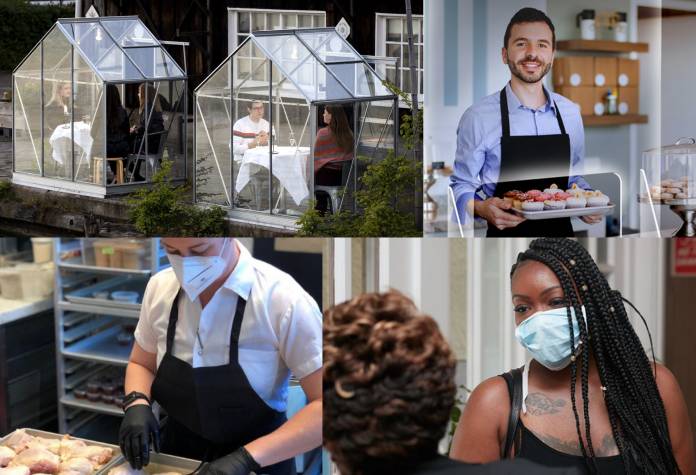For 14 years, Marcia Gagliardi has taken both a bird’s-eye and a fork’s-tine view of the local dining and drinking scene. tablehopper, her invaluable site and newsletter, dashes around town reporting on the latest openings, closing, shiftings, and revisionings of the diviest watering holes to the fanciest Michelin star-ees. She’s the only person I can hang with for shots of Cuervo in the Tenderloin followed by gold-leaf-blanketed sea urchin at Saison. (Recently she even brought cannabis into her fold of expertise, launching mymilligram to gently introduce newbies to the newly legalized industry’s more interesting products.)
Gagliardi has always been civic-minded in her coverage, but when COVID hit, she knew she needed to put that deliciously deep mental database to work, bringing attention to the people helping to feed their community—and sharing the stories of the brave souls trying to weather the shutdown’s devastating impact.
She’s now launched On The Fly, a twice-weekly podcast that investigates “the impact of the coronavirus on the hospitality ecosystem, with thousands laid off, businesses indefinitely closed, and a disastrous ripple effect that doesn’t seem to end.” With On the Fly—named for familiar kitchen slang for when a dish has been forgotten or is a last-minute change, and the kitchen needs to drop everything to push it through quickly—Gagliardi is also hoping to connect food and beverage workers to each other by talking about all the change in the industry, sharing what’s been working (and not) in terms of the tremendous pivot most establishments have enacted, and how listeners can help.
So far, you can find episodes discussing everything from the mayor’s recent 15% cap on third-party delivery app commission charges to the secrets of Nopa’s fried chicken takeout. A “Two Top” feature in each episode highlights “two things listeners should know about, like a can’t-miss takeout special, restaurants feeding their fellow industry workers, or an initiative to support.” And, the part I like best, On the Fly shares good news about how the community is stepping up to feed the hungry and help each other.
I spoke with Gagliardi about all this, and especially what she thinks the future of dining and drinking in SF might look like, sadly still so far in the future it seems.

48 HILLS Tell me how the idea of On the Fly came about — have you done podcasts before? And what podcasts do you, yourself listen to?
MARCIA GAGLIARDI The pandemic struck our restaurant/hospitality industry so violently—one day, everything was open, and then boom, your dining room is closed, your revenue just vaporized, you have 85 people depending upon you, good luck figuring it out, everyone! So brutal. I started posting Instagram Stories immediately, trying to spread the word about who was offering takeout and delivery, and quickly realized that writing articles for tablehopper about openings and closures was going to be too massive and too volatile, it all kept changing by the hour. (It still does.) I simply wasn’t going to be able to write fast enough.
As I was speaking to restaurateurs and chefs and small business owners, I felt like I shouldn’t be the only ones hearing their stories. It’s such a dramatic moment in time, and I wanted industry folks to be able to hear and learn from each other, and for the dining public to empathize and understand the depths of hell our hospitality industry is going through. And the restaurant industry has so quickly mobilized to feed others, it’s staggering to watch. It’s so inspiring. I want people to be able to feel closer to all these moments! So, the idea for the podcast was hatched, on the fly, just like its name. I have an incredible volunteer, Lola Yen, a tablehopper newsletter reader who became my ad hoc producer and editor! She has been the greatest gift, thanks universe! We have figured this all out together.
I’ve never done a podcast, although I used to do voiceover 20 years ago—I did radio and TV commercials, and about eight years ago, I had a weekly segment on KGO called “You Gotta Eat This” that I wrote and voiced. I honestly don’t listen to many food podcasts, but the ones I do listen to on my afternoon walks are all about weed: Broccoli Talk, How to Do the Pot, and Sara Payan’s Planted.
48 HILLS What are some of the memorable stories you’ve highlighted so far? I know you’ve talked to a variety of people in the industry—have there been any surprising revelations? Are people hopeful at all?
MG Oh, the most important episode so far was with chef Joanna Karlinsky, who is cooking out of her home kitchen and directly feeding the unhoused on the streets a few times a week. I went to the Tenderloin a few weeks ago to support a tiny Vietnamese restaurant I love, and was so shocked by what I saw on Hyde Street. It was one of the most desperate scenes I’ve ever seen on the streets of SF, and I’ve lived here for 25 years. I was so distressed about it. Blatant suffering and such dangerous conditions in a pandemic. But I didn’t want to be the one to tell the story of what is happening on the streets of the Tenderloin, I needed someone closer to it.
Soon thereafter, I saw a Facebook fundraiser for chef Joanna so she could continue to feed people, and I jumped at the opportunity to speak with her so we could listen to what she was seeing firsthand. She’s my hero right now, what a one-woman army. It was a really hard episode to listen to, but some incredible good has come out of it! Sam Mogannam of Bi-Rite reads my newsletter and listened to the episode, and not only secured a pallet of water for Joanna to be able to hand out to those in need, but he hooked her up with the currently empty 18 Reasons kitchen so she can prepare and store food there. What a guy. We all gotta help keep our angels flying.
As for hope, I see two kinds of people. There are those clinging more to the ways it has always been, and they’re thinking of how to do things when restaurants can open again, and being solutions-oriented, but there is so much that is unknown right now—starting with the revelation of how many people will feel secure enough to dine out. The only sure thing is that it’s going to be challenging and impossibly hard in upcoming months, for many reasons.
The revolutionaries are the ones that have more hope because they see a broken system that needs rebooting and they have ideas about changing things in order for this next era of restaurants to thrive and survive, from workers’ rights and the cost of food to food-sourcing. Big conversations and actions are going to come out of this time. We’re seeing lots of activism arise.
48H I love the idea of the “two-top” moment in the podcast, which gives little insider tips about how listeners can help or take action—can you share a couple of those?
Thanks, yeah, I wanted to figure out an easy way for people to learn about initiatives and ways to help, and one of the top initiatives I want to be sure everyone knows about is SF New Deal. This powerful collective of volunteers is fundraising, and working with and paying 48 restaurants to make meals that then get distributed to community organizations, shelters, churches, SROs, and more. They’re doing incredible work—they’ve delivered over 140,000 meals to people in need.
I also like to shout-out small restaurants that are open and continuing to make amazing food, like Miss Ollie’s in Old Oakland, and Tycoon Thai in the Tenderloin.

48H So here’s a big question: As a longtime observer of the dining scene, what in your mind will the future look like?
As someone who adores bars and restaurants, and typically spends six nights a week in them, the future is going to be very fuzzy and challenging for at least the next year, certainly until there’s a vaccine. We’re going to lose so many businesses, especially with all this rent that will be due (unless there are some big changes and forgiveness there).
Restaurants and bars are by nature packed environments: in the kitchen, behind the bar, and in the dining room. There are greater risks of exposure for employees and among fellow diners (honestly, the bathroom situation alone is a huge issue), and running kitchens with six feet distancing (how?) and businesses at half-capacity won’t keep the lights on. Expanding to sidewalk seating will help (with hopefully closed city streets and more parklet seating), but again, it’s not the answer. Delivery and takeout are going to continue to be a huge part of this transitional landscape, especially for those who are immunocompromised and can’t risk exposure.
We love to gather, and break bread, and taste each other’s food, but it’s all changing as we move from communal tables and family-style menus to plexiglas dividers and individual portions. Bye-bye, buffets! Everyone in masks. I’ve been watching what they’re doing in restaurants in Asia, and it makes we wonder what the Bay Area is going to borrow or innovate, like guests needing a bag to store their mask while they eat, and no-contact ways to view a menu, order, and pay your bill. I’m so sad we’re losing our places of gathering and connecting and celebrating for now.
And escape! Restaurants are a break from our kitchens, and responsibilities, our lives. People are still going to go out, but the question is how many will, and for which experiences? And who will be open? And how will those interactions make everyone feel? Servers, chefs, bartenders, diners…all those interactions will change. It’s going to be a bizarre chapter in our existence as social beings.
I especially worry about bars. Being in proximity with strangers is less desirable than ever right now, and we’re going to need so much space in between barstools. The new sanitary wipe that will be needed around the glass before handing it to the customer, how to order, deal with cash… The mind reels. The way we eat, drink, and gather is all being re-evaluated, every touchpoint. Have a listen to the recent On the Fly episode with Karri Kiyuna of Wildhawk, who shares about running a bar during a pandemic.
The biggest thing right now is food insecurity—restaurants are an integral part of figuring out how to help feed people and get through this crisis.
48H Finally, you are also a queen of cannabis—something that’s been deemed “essential” during this time. What are some quick impressions you have of the relationships between the hospitality and cannabis industries?
MG I prefer the title Contessa, LOL. There are so many similarities. Cannabis is so communal! SF has cultivated amazing cannabis culture, from gatherings to dinners to events, and now people can’t come together like we used to. It’s such a shame because the community is so strong and has been trying to build alliances and get through these first years of legalization together.
The industry was already having a tough time pre-pandemic, with diminished access to investors, and now it’s only harder. So many businesses need more capital to survive on the regulated market, so we’re sadly going to see a number of them go under. Guess what? Capitalism sucks! Ugh.
And all the dependance on delivery or curbside pickup at dispensaries, it’s interesting to see the parallels with restaurants in that way. But, a big shout-out to weed for getting many of us through this time. My best friend right now. I wrote a piece for the pandemic: Tips on How to Microdose for Sanity, Sleep, and Self-Care While Staying at Home. It’s the perfect time to experiment!

48H Bonus question: What takeout or delivery have you eaten and loved lately from local restaurants or bars? Or what are some recipes you’ve made at home using locally sourced ingredients?
MG I just love the fresh dishes and style of Troya—the vegetable moussaka and dolmas (handmade by the owner’s mother-in-law, who got stuck here during the shutdown) are Turkish treasures, perfect for this warm weather. The Kirimachi ramen kit is a winner (and a deal!).
One big silver lining out of this mess has been the Nopa fried chicken, a takeout dish they added to their menu and it gives me life (you can listen to the secret of it in the first episode of On the Fly with chef Laurence Jossel). And now they’re offering their custard French toast as a takeout kit, and it’s pure magic. But no, it’s just not the same as sitting in Nopa on a sunny Sunday morning. I look forward to that time, and that moment, who knows when that will be, and if I’ll be surrounded in plexiglas.




